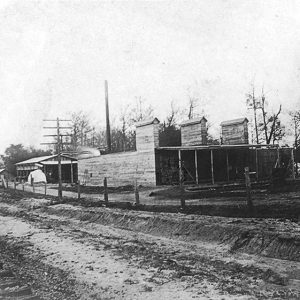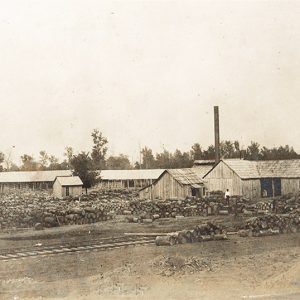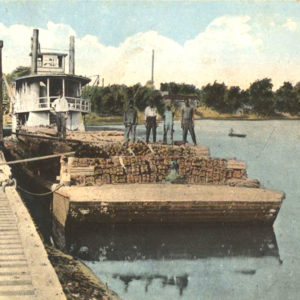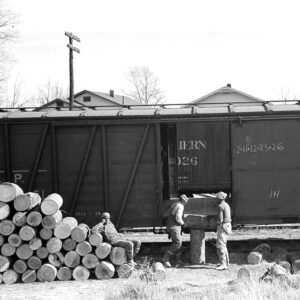calsfoundation@cals.org
Stave Mills
Stave mills produce the narrow strips of wood that compose the sides of barrels. Barrels were vital for the transportation of goods in the days before easily fabricated boxes and waterproof plastic containers. Stave mills were frequently established in areas where timber was being harvested so as to take advantage of the easy availability of needed resources. As such, they were an important component of local economies in Arkansas, with small towns in timber-producing areas possessing at least one, and larger cities with railroad connections often having several.
Stave mills processed either hardwood—used to make “tight,” or waterproof, barrels—or softwood—used to make “slack” barrels, or those that were used for transporting dry goods and foodstuffs. Logs were cut near the stave mill or shipped in. Depending upon the kind of stave being produced, logs were cut into thirty-two- or thirty-six-inch lengths; pieces meant to be “tight” staves were sent to another sawyer for proper shaping. Stave cutting was dangerous work, and injuries were common.
Stave mills were often established by Northern lumber interests to take advantage of Arkansas timberland. From the late nineteenth century to the early twentieth century, towns across the state had numerous stave mills attached to them—even fairly small towns. Woodruff County proves a good example of this. Cotton Plant had four operating in its vicinity at one time: Pioneer Stave Mill, Eckhart and Leonard Mill, and Home Stave Mill were established in the 1910s and remained in operation until 1925 or 1926, while Daggett Stave Manufacturing Company built a mill in 1920, though it soon went under. Another mill established by the latter company by 1912 in the nearby town of Daggett (Woodruff County), however, remained in operation until 1938. Numerous other stave mills operated in Woodruff County, such as two mills owned by Kelly Cooperage of Kansas City, Kansas, in the towns of Hunter and Penrose. The Hunter mill lasted until 1938, when it was relocated to DeWitt (Arkansas County). Another mill in Augusta (Woodruff County), in operation as early as 1912, closed in the late 1940s.
Leslie (Searcy County) once had a stave mill operation that was advertised as the largest of its kind in the world. Shortly after the Missouri and North Arkansas Railroad (M&NA) was extended to Leslie in 1903, the town’s first stave mill was erected. Three years later, the H. D. Williams Cooperage Company of Poplar Bluff, Missouri, relocated its entire factory to Leslie. This plant covered sixty-eight acres and produced anywhere from 3,000 to 5,000 barrels a day.
As barrels began to be replaced by plastic containers, a trend that took hold especially during the World War II years, stave mills closed. A few remain in business across the country, however, making barrels either for decoration or for use by wineries and distilleries. Gibbs Brothers Cooperage in Hot Springs (Garland County) still assembles barrels, though it has not produced its own staves since the 1970s. Several places across Arkansas apparently take their names after stave mills: both Pope and Marion counties possess a geographical feature dubbed Stave Mill Hollow, while Cleveland County has a town called Staves; just below the Missouri state line at the Craighead–Greene county line is Stave Island, while south of that, spanning the border of Crittenden and Mississippi counties, is Stave Lake.
In July 2022, the Independent Stave Company, a manufacturer of high-quality oak barrels and cooperage products, broke ground for a state-of-the-art mill facility in the Batesville (Independence County) area to produce staves for use in bourbon and wine barrels. The company, which is considered the largest barrel maker in the world, announced plans to invest more than $30 million in the facility and create dozens of new jobs.
For additional information:
McGregor, Mrs. Dale. “Stave Mills—A Vanished Industry.” Rivers and Roads and Points in Between 4 (Summer 1976): 17–22.
Rowe, J. C. “Gibbs Brothers Cooperage Company.” The Record 45 (2004): 124–129.
Staff of the CALS Encyclopedia of Arkansas
 Business, Commerce, and Industry
Business, Commerce, and Industry Cass Stave Mill
Cass Stave Mill  Frisco Stave Company
Frisco Stave Company  Gid Stave Mill
Gid Stave Mill  Lasater and Bailor Stave Mill
Lasater and Bailor Stave Mill  Manila Stave Mill
Manila Stave Mill  Newport Staves
Newport Staves  Paragould Stave Mill
Paragould Stave Mill  Stave Logs
Stave Logs 




I was born in McClelland, Arkansas, and my family moved to the community of Daggett, Arkansas, where my father went to work in the stave mill there. My earliest recollection is that the mill was run by a family named McCrea who lived in a stone house in the community. All the rest of the houses were wood. There were a few shotgun houses where some of the mill workers lived. The main mill was on a bluff overlooking the Cache River. My grandfather, John Henry Wade, lived in a wooden shack with a dirt floor very close to the mill and made a “home brew” form of beer. This is where a lot of the men gathered on Friday and Saturday nights to “have a few” and play cards. There was the main mill where the logs were cut and put in hot boxes and then were sent to a cutting machine where they were sliced into a certain thickness. The operator was known as Uncle Jimmy (no relation) and had parts of some fingers missing that had been caught in the machine. The logs were then taken to drying sheds. After drying, they were taken to the stave cutting shed where my father worked. He operated a cutting machine that trimmed and shaped them. He then put them into sorting bins where they were bundled into bales of 50 and loaded into a railroad car for shipment. We moved from there in the late 1940s as mill work was slowing down after the war. I can remember my father stating that they were making stave for some of the barrels that were used in shipping supplies for the war. The entry refers to Dale McGregor; I went to school in Cotton Plant and was in the same grade as Sara, Dales sister.